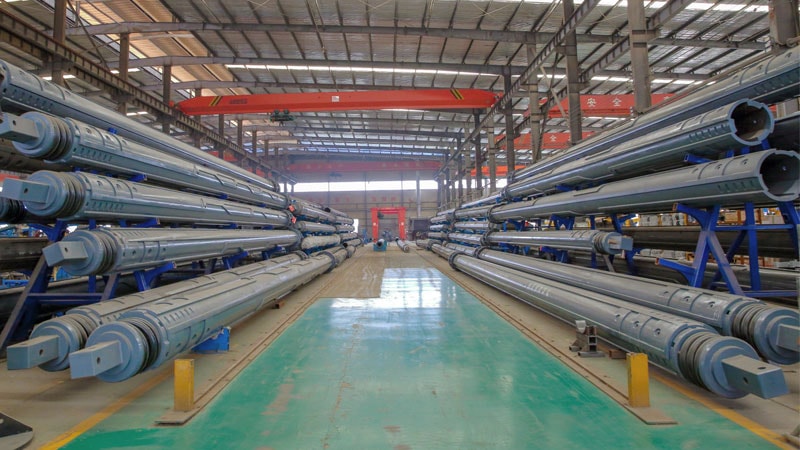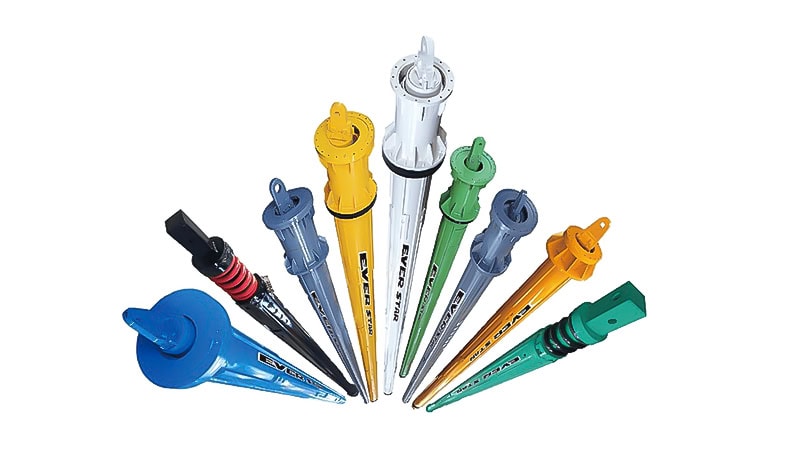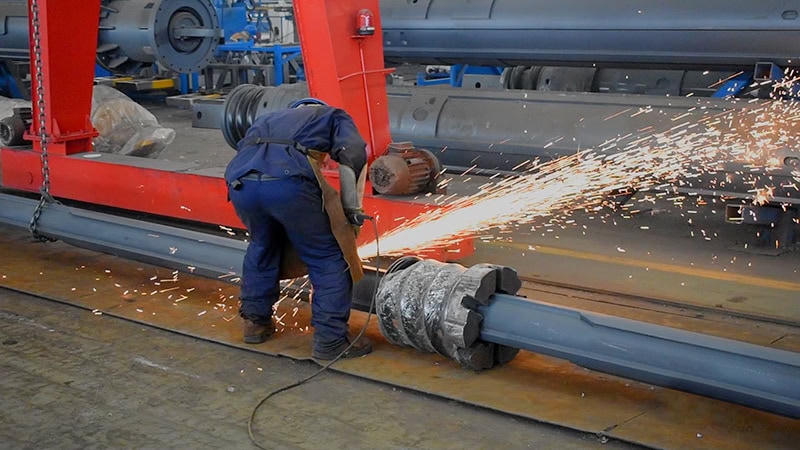
Key Takeaways:
- Choosing telescopic Kelly bars with verified origin and quality certificates from trusted manufacturers ensures durability and reliable drilling performance.
- Friction Kelly bars provide smooth torque transfer through telescopic section contact, ideal for softer soils and moderate drilling depths.
- Interlocking Kelly bars use mechanical locks for enhanced torque and rigidity, suited for tough soils and demanding foundation work.
- Efficient transmission of torque and crowd force via the Kelly bar and rotary drive tool enables precise, deep foundation drilling.
Telescopic Kelly bars are vital extensions on rotary drilling rigs, designed to adjust drilling depths smoothly and efficiently. They are essential for foundation work across varied soil conditions and project scales, including buildings, bridges, and infrastructure developments where controlled boreholes are critical.
Understanding the key types, their specific benefits, and proper maintenance practices helps construction professionals choose the right Kelly bar for each job. This leads to improved drilling accuracy, reduced downtime, and longer equipment life.
This article explains the main types of telescopic Kelly bars, how they operate, and their common applications in construction. Everstar Machinery shares insights to support better decision-making and optimize drilling operations.
Overview of the Telescopic Kelly Bar and Its Function in Drilling Rigs

The telescopic Kelly bar is a specialized tool designed for efficient deep foundation drilling. Its hydraulic rotary drilling rigs enable the bar’s hydraulic extension and retraction to adjust to varying depth ranges, minimizing downtime and ensuring smooth torque transfer during operation.
What Is a Telescopic Kelly Bar?
It is a hollow, multi-section tubular Kelly section tool mounted on rotary drilling rigs. It hydraulically extends and retracts to adapt to different drilling depths, enabling continuous foundation piling without frequent equipment changes.
How Telescopic Kelly Bars Operate in Rotary Drilling
Torque and vertical crowd pressure transfer through the telescopic sections, allowing drilling to continue as depth increases. The Kelly bar connects the rig’s rotary table with the drill string, creating a unified system for smooth and efficient drilling. The crowd system concurrently applies downward force as the torque rotates the drill bit.
Kelly Tool Integration and Compatibility
Telescopic Kelly bars integrate with key components such as Kelly boxes, swivel heads, and drive adaptors. These lock devices and the mechanical locking system are essential for secure torque transmission and tool connection, ensuring reliable performance in demanding drilling applications. Some models also incorporate a damping noise system to reduce vibration during operation.
Types of Telescopic Kelly Bars and Their Key Characteristics

Telescopic Kelly bars mainly come in interlocking and friction-based types, each suited for specific soil conditions and project demands. Understanding these differences helps ensure maximum efficiency and durability across various drilling environments.
Interlocking Kelly Bars
Interlocking Kelly bars feature drive ribs and a full lock Kelly bar style mechanical locking system between telescopic sections. This design offers maximum torque transmission and rigidity, ideal for hard soils and tough drilling environments requiring high strength and stability.
Friction Kelly Bars
Friction Kelly bars transfer torque through frictional contact between sections. Their simpler construction allows easier maintenance and lower costs, making them well-suited for softer soils and moderate drilling depths.
Variations by Number of Telescopic Sections and Dimensions
Telescopic Kelly bars range from 2 to 6 segments, with length and diameter tailored to rig capacity and drilling depth. The number and size of sections directly affect drilling reach, speed, and adaptability to project needs.
Benefits of Using Telescopic Kelly Bars in Construction Projects

Telescopic Kelly bars offer operational flexibility, efficient torque transfer, and easier transportation. These benefits combine to improve drilling productivity, reduce downtime, and simplify logistics, making them essential tools for modern foundation projects.
Adjustable Drilling Depth and Operational Flexibility
The telescoping feature minimizes frequent bar changes, speeding up foundation pile drilling and reducing downtime. This flexibility allows crews to adapt quickly to changing drilling depths without interrupting operations, boosting overall project efficiency.
Enhanced Torque Transfer and Load Capacity
Interlocking telescopic Kelly bars provide superior torque transfer and load capacity. This ensures deeper, straighter, and more precise drilling in challenging soil and rock, reducing wear on equipment and improving drilling accuracy.
Space and Transportation Efficiency
When retracted, telescopic Kelly bars are more compact than standard Kelly bars. This compactness eases transportation and storage logistics, which is especially valuable on large construction sites with tight spaces or complex equipment movement, helping to ensure minimum weight during handling.
Typical Applications of Telescopic Kelly Bars in Foundation Drilling

A telescopic Kelly bar consists of multiple tubular sections designed to extend and retract, enabling deep foundation drilling across a variety of projects. Their adaptability suits different rig types and drilling methods, making them essential for complex construction site requirements.
Use in Rotary Drilling and Bored Piling
They play a vital role in rotary drilling and bored piling for buildings, bridges, and infrastructure. Their precise control over drilling boreholes ensures stability and safety in deep foundation work, even in challenging soil conditions.
Compatibility with Various Drill Rig Types
Telescopic Kelly bars are compatible with crawler rigs, hydraulic rotary rigs, and truck-mounted rigs. This flexibility allows their use across diverse site conditions worldwide, enhancing project adaptability and equipment efficiency.
Supporting Specialized Drilling Techniques
These bars integrate seamlessly with specialized piling techniques like Continuous Flight Auger (CFA) drilling. They also work well alongside other drilling tools to manage complex soil profiles and improve foundation quality.
Maintenance Tips for Telescopic Kelly Bars to Maximize Service Life

Maintaining telescopic Kelly bars properly is key to extending their lifespan. Following regular inspection, lubrication routines, and choosing high-quality materials from trusted manufacturers like Everstar helps ensure consistent, reliable drilling performance.
Routine Inspection for Wear and Structural Integrity
Perform visual and mechanical checks frequently, focusing on cracks, key plate wear, telescopic joint condition, and weld integrity. Early detection of issues prevents failures, enhances safety, and keeps operations running efficiently.
Lubrication and Protective Measures
Keep sliding parts well-lubricated and regularly inspect protective coatings to avoid corrosion and abrasive damage. These steps reduce wear and help your Kelly bars maintain smooth operation under tough site conditions.
Choosing High-Quality Materials and Certified Manufacturers
Opt for telescopic Kelly bars made from high-strength steels like 35CrMo with origin and quality certificates. Bars made under ISO 9001-certified processes ensure consistent quality and durability. Partnering with trusted suppliers like Everstar Machinery also gives you access to replacement parts, technical service, and long-term support.
FAQs
What is the primary difference between telescopic and fixed Kelly bars?
Telescopic Kelly bars adjust length smoothly through multiple segments, allowing drilling at varying depths without changing bars. Fixed Kelly bars have a single rigid length, limiting flexibility and requiring bar changes for different drilling depths.
How do interlocking Kelly bars improve drilling performance?
Interlocking telescopic Kelly bars use mechanical locks between sections for maximum torque transfer and rigidity. This design enhances drilling precision, especially in hard soils or tough environments, enabling deeper and more efficient foundation drilling compared to friction-based bars.
Can telescopic Kelly bars be used with all types of rotary drilling rigs?
Yes, telescopic Kelly bars are compatible with various rotary drilling tools, including crawler rigs, hydraulic rotary rigs, and truck-mounted rigs. This flexibility makes them suitable for diverse site conditions and drilling methods worldwide.
What is a Kelly tool, and how does it integrate with telescopic Kelly bars?
A Kelly tool includes components like Kelly boxes, swivel heads, and drive adapters. These interface with telescopic Kelly bars to transfer torque and connect drilling tools, ensuring smooth power delivery and system integration during foundation drilling.
How often should telescopic Kelly bars be maintained and inspected?
Regular maintenance and inspections should be scheduled based on project intensity, but ideally, visual and mechanical checks occur frequently. Routine lubrication, coating inspections, and wear assessments prevent failures, extend service life, and ensure safe, efficient drilling operations.
Conclusion – Key Insights on Telescopic Kelly Bar Drilling Tools
Telescopic Kelly bars are essential for foundation work, offering adjustable length and strong torque transfer, especially with interlocking types. They improve drilling precision and efficiency across varied conditions and projects.
Choosing quality bars and maintaining them properly extends service life and reduces downtime. These versatile tools are vital for modern rotary drilling rigs, helping construction teams optimize performance and achieve better results.
Discover Reliable Telescopic Kelly Bars
Contact Everstar Machinery’s specialists to get high-quality, custom telescopic Kelly bars and Kelly tools built for your rotary drilling rigs and foundation needs. Explore Everstar’s catalog for dependable solutions that improve drilling performance and project success.